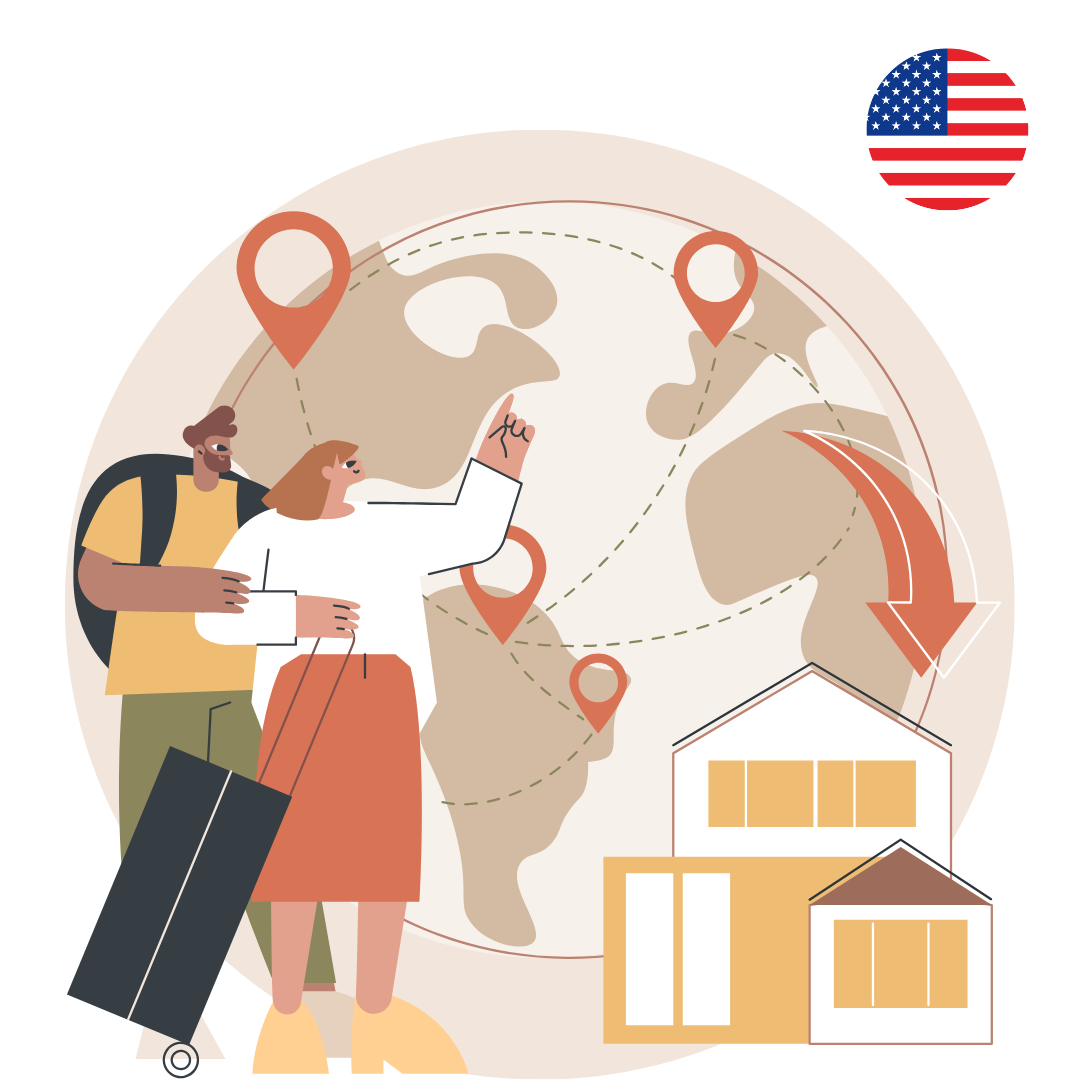General Information about the USA:
The United States of America (USA), officially known as “The United States of America,” is a country in North America. It is recognized as one of the largest and most influential countries in the world, known for its impact on the global economy, culture, military, and politics. Below is an overview of the USA:
Geographic Location:
Location: The USA is located in North America, featuring diverse terrains, including mountains, lakes, rivers, coasts, and deserts.
Borders: The country shares its northern border with Canada and its southern border with Mexico.
Administrative Divisions: It consists of 50 states and one special district (Washington, D.C.).
Population and Culture:
Population: With over 330 million people, the USA is the third most populous country in the world.
Cultural Diversity: The USA is one of the most culturally diverse countries globally, with residents from all parts of the world.
Economy:
Economic Power: The USA is considered one of the world’s largest and most advanced economies.
Economic Diversity: It has various industries, including technology, telecommunications, automotive, food, healthcare, mining, agriculture, and many others.
Culture and Civilization:
Cinema and Music: The USA is a hub for the global cinema and music industries.
Museums and Historical Sites: The country has numerous museums, historical centers, and tourist attractions that draw millions of visitors annually.
Politics:
Political System: The USA is a federal democratic republic.
Military Power: The USA boasts one of the world’s largest and most powerful military forces.
Other Key Facts about the USA:
Official Language: English
Capital: Washington, D.C.
Currency: United States Dollar (USD)
Time Zones: Multiple time zones from west to east.
In summary, the USA is a highly significant and diverse country with a vast global influence in many areas, including culture, economy, politics, and technology.
Geography and Climate:
The USA is a large country in the Western Hemisphere, covering approximately 9.8 million square kilometers, located in North America. The country borders Canada to the north, Mexico to the south, the Atlantic Ocean to the east, and the Pacific Ocean to the west. The geography and climate of the USA are highly diverse and widespread. Here’s an overview:
Eastern Coast: This region includes states like New York, Florida, and Virginia, featuring long, busy coastlines and large cities like New York City and Miami.
Central USA: Includes central states such as Illinois, Texas, and Ohio, known for vast agricultural and industrial lands.
Western USA: Encompasses states like California, Nevada, and Washington, with a variety of landscapes, including beaches, mountains, and deserts. Major cities like Los Angeles and San Francisco are located here.
Southwest: States like Arizona and New Mexico are known for their expansive deserts and dry climate.
Pacific Northwest: States like Washington and Oregon feature a temperate climate and vast forests.
The climate in the USA varies:
Temperate: Found on the east coast and in the Pacific Northwest, with mild winters and warm summers.
Continental: Found in the central regions, with hot summers and cold winters.
Tropical: Found in southern states like Florida, with hot, humid summers and mild winters.
Desert: Found in the Southwest, with extremely hot summers and mild, dry winters.
Mediterranean: Found on California’s coast, with hot, dry summers and mild, wet winters.
Mountainous: Found in regions like the Rockies, where the climate can be highly variable, with cool summers and cold, snowy winters.
The USA’s geographical and climatic diversity allows it to house various ecosystems, from dense forests to arid deserts, long coastlines, and towering mountains.
Economy of the USA:
The USA boasts one of the world’s largest and most advanced economies, driven by a variety of factors such as abundant natural resources, a diverse labor force, and advanced technology. Below are some key elements of the USA’s economy:
Main Sectors:
Services Industry: The largest sector, which includes financial services, insurance, consulting, healthcare, education, and tourism. Services contribute around 80% of the country’s GDP.
Manufacturing: This sector includes the production of goods like automobiles, electronics, chemicals, and machinery. The USA is one of the world’s largest producers of cars and airplanes.
Technology and Information: This sector includes major tech companies like Apple, Google, Microsoft, and Amazon. Silicon Valley in California is a global tech hub.
Agriculture: The USA is a major producer and exporter of agricultural products like wheat, corn, soybeans, and meat. States like Iowa and Nebraska are known for their agricultural production.
Trade and Commerce:
The USA is a major player in global trade. It maintains extensive trade relations with many countries and relies heavily on imports and exports. Its key trading partners include China, Canada, Mexico, Japan, and Germany.
Labor Market:
The labor market in the USA is highly diverse, with a wide range of skills and specialties. Unemployment rates are typically low, and wages vary by occupation and geographic region. The USA also hosts many immigrant workers, who play a vital role in the economy.
Innovation and Research:
The USA leads the world in research and development (R&D), with significant investments in technology, medicine, basic sciences, and engineering. Renowned universities and research centers like MIT, Harvard, and Stanford are located in the USA.
Financial System:
The USA has a sophisticated financial system, including stock markets, banks, and other financial institutions. Wall Street in New York is one of the world’s most important financial centers. The Federal Reserve (the central bank of the USA) plays a key role in regulating the country’s monetary policies and economy.
Economic Challenges:
Despite its economic power, the USA faces several challenges, including income inequality, high national debt, and issues related to climate change. Government policies also significantly affect the country’s economic growth and stability.
Foreign Investment:
The USA is one of the world’s largest recipients of foreign direct investment (FDI). Many multinational companies operate in the USA, and significant investments are made in various industries.
The USA’s economy, due to its dynamic and diverse structure, remains one of the most influential and impactful economies in the world.
Culture of the United States of America
The culture of the United States is highly diverse and multifaceted, shaped by the history of immigration and cultural amalgamation from around the world. Below are some key aspects of American culture:
Cultural Diversity: As a nation of immigrants, the U.S. is a mix of various cultures, races, and ethnicities. This diversity is evident in all aspects of life, from food and music to art and religion. Each ethnic and racial group has contributed its traditions and beliefs to the overall culture of the country.
Art and Literature:
Literature: American literature includes prominent authors like Mark Twain, Ernest Hemingway, F. Scott Fitzgerald, and Toni Morrison. It reflects various themes, including the American Dream, race, and identity.
Cinema: Hollywood is the center of the global film industry, and the U.S. is the largest producer of motion pictures. American films are renowned worldwide and have a significant influence on global culture.
Music: American music is incredibly diverse, with genres like jazz, blues, rock, hip-hop, and country all developing in the U.S. Famous musicians like Elvis Presley, Michael Jackson, and Madonna have had a massive impact on world music.
Holidays and Celebrations: Americans celebrate a wide range of national and local holidays. Some of the most important include Independence Day (4th of July), Thanksgiving, Christmas, and Halloween.
Sports: Sports play a significant role in American culture. Popular sports include American football, basketball, baseball, and hockey. Professional leagues such as the NFL (American football), NBA (basketball), MLB (baseball), and NHL (hockey) have large followings.
Food: American food is a blend of traditional dishes and immigrant influences. Fast foods like hamburgers and pizza are known worldwide. Additionally, different regions of the U.S. have their local and unique foods, such as BBQ in the South and seafood on the East and West Coasts.
Religion: The U.S. is one of the most religiously diverse countries in the world. Christianity has the largest following, but Judaism, Islam, Buddhism, and Hinduism are also present. Freedom of religion is a fundamental principle of the U.S. Constitution.
Media and Communication: The U.S. is a global leader in media and communications. American media, including television, radio, and the internet, significantly influence global culture and politics. Major companies like CNN, ESPN, and Netflix are based in the U.S.
Education and Universities: The U.S. is home to some of the world’s best universities, such as Harvard, MIT, and Stanford. The American education system is renowned for its diversity and high quality, attracting students from around the world.
Family and Lifestyle: American families are highly diverse in size and structure. The American lifestyle often emphasizes individualism, focusing on personal freedom and autonomy. However, family values remain important, and family gatherings play a key role in social life.
American culture, known for its dynamism and ability to absorb and adapt elements from global cultures, remains one of the most influential and innovative in the world.
Population of the United States
As of 2024, the population of the United States is estimated to be around 334 million people, making it the third most populous country in the world after China and India. The U.S. population is highly diverse in its racial and ethnic composition. Below are some demographic details:
Racial and Ethnic Composition:
White (Non-Hispanic): The largest racial group, comprising about 60% of the population.
Hispanic or Latino: About 18% of the population and one of the fastest-growing groups.
African American: Approximately 13% of the population.
Asian: Around 6% of the population.
Native American and Alaska Native: Less than 2%.
Native Hawaiian and Pacific Islander: Less than 1%.
Geographical Distribution:
Urban Areas: Over 80% of the U.S. population lives in urban areas. Major cities like New York, Los Angeles, Chicago, and Houston are the most populous.
Rural Areas: A small portion of the population lives in rural areas, primarily in the central and southern parts of the country.
Population Growth:
Growth Rate: The U.S. population growth rate has slowed in recent decades, currently around 0.7% per year, mainly due to declining birth rates and increasing immigration.
Immigration: The U.S. remains a primary destination for immigrants from around the world, which plays a significant role in population growth and cultural diversity.
Age Structure:
Children and Adolescents (0-17 years): About 22% of the population.
Adults (18-64 years): About 63%.
Seniors (65 years and older): About 15%, with the proportion of seniors rising due to increasing life expectancy.
Gender Ratio: The gender ratio is almost balanced, though women slightly outnumber men, comprising about 50.8% of the population, while men make up about 49.2%.
Education Level: The education level in the U.S. is high, with about 90% of the population having a high school diploma and over 34% holding a bachelor’s degree or higher.
Languages:
English: The primary and official language of the U.S.
Spanish: The second most spoken language, with a significant portion of the population using it.
Other Languages: Due to immigration, many other languages are spoken, including Chinese, Tagalog, Vietnamese, Korean, and many more.
Religion:
Christianity: The largest religion, accounting for about 70% of the population.
Unaffiliated or Non-religious: About 23% of the population.
Other Religions: Include Judaism, Islam, Buddhism, Hinduism, etc.
The population of the U.S. is one of the most complex and diverse in the world, not only in racial and ethnic composition but also in language, religion, and lifestyle.
Capital of the United States
The capital of the United States is Washington, D.C. As the nation’s political and administrative center, it hosts many governmental institutions and historical landmarks.
History of the Capital:
Founding: Washington, D.C. was founded on July 16, 1790, and named after George Washington, the first president of the U.S. “D.C.” stands for “District of Columbia.”
Design: The city’s layout was designed by Pierre Charles L’Enfant, a French-American engineer and architect. He designed a network of streets based on radial axes, along with green spaces and public gardens that enhance the city’s beauty and functionality.
Government Institutions Located in the Capital:
The White House: The official residence and office of the U.S. President.
The U.S. Capitol: The seat of the U.S. Congress, where both the House of Representatives and the Senate meet.
The Supreme Court: The highest judicial body in the U.S., responsible for making crucial legal decisions.
Federal Departments and Agencies: Washington, D.C. is home to many federal departments and agencies, including the State Department, the Department of Defense, and the Department of the Treasury.
Culture and Museums in the Capital:
Museums and Galleries: Washington, D.C. hosts many renowned museums and galleries, including the Smithsonian Institution, the National Air and Space Museum, the National Museum of Natural History, and the National Gallery of Art.
Monuments and Memorials: Iconic monuments such as the Lincoln Memorial, the Washington Monument, the Vietnam Veterans Memorial, and the World War II Memorial are among the city’s top tourist attractions.
Population and Demographics:
Population: Washington, D.C. has a population of about 700,000, but the larger Washington metropolitan area has a population exceeding 6 million.
Diversity: The city is multicultural, with residents from various racial and ethnic backgrounds.
Education and Research:
Universities: Washington, D.C. is home to prestigious universities such as George Washington University, Georgetown University, and American University.
Research Centers: The city is also home to many research centers and think tanks that focus on a wide range of scientific and social topics.
Local Politics and Government: Washington, D.C. is governed by a mayor and a city council. However, due to its unique status as a federal district, the U.S. Congress has oversight power over its local government.
Capital’s Economy:
Public Sector: The majority of Washington, D.C.’s economy revolves around government-related activities and public services.
Private Sector: In addition to government institutions, the private sector plays an important role, particularly in law, lobbying, consulting, and education.
Transportation System:
Public Transportation: Washington, D.C. has an advanced public transportation system, including a metro, buses, and bike-sharing services.
Airports: The city is served by three major airports, including Ronald Reagan National Airport, Washington Dulles International Airport, and Baltimore-Washington International Airport.
Washington, D.C., as the political and cultural capital of the United States, plays a central role in both the national and international life of the country. Its rich history, prestigious institutions, and cultural landmarks make it one of the most important and influential cities in the world.




